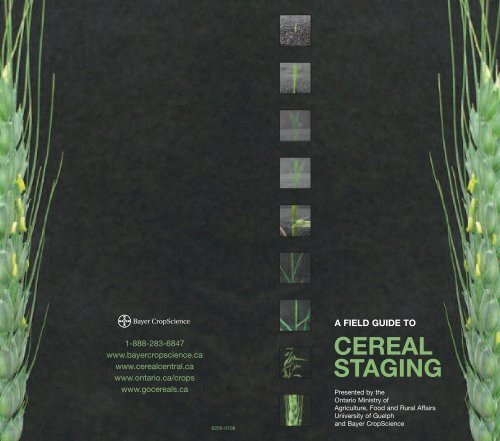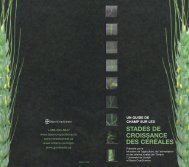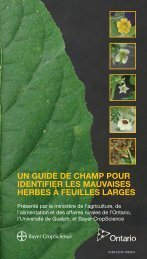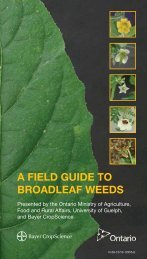cereal staging - Bayer CropScience
cereal staging - Bayer CropScience
cereal staging - Bayer CropScience
Create successful ePaper yourself
Turn your PDF publications into a flip-book with our unique Google optimized e-Paper software.
1-888-283-6847www.bayercropscience.cawww.<strong>cereal</strong>central.cawww.ontario.ca/cropswww.go<strong>cereal</strong>s.ca6250-0108A FIELD GUIDE TOCEREALSTAGINGPresented by theOntario Ministry ofAgriculture, Food and Rural AffairsUniversity of Guelphand <strong>Bayer</strong> <strong>CropScience</strong>
ContributorsJamie LarsenPhD. CandidateDepartment of Plant AgricultureUniversity of Guelph - Technical InformationMike CowbroughProvincial Weed SpecialistOMAFRA - Technical ReviewDuane FalkAssociate ProfessorDepartment of Plant AgricultureUniversity of Guelph - Technical ReviewGilles QuesnelField Crops, IPM Program LeadOMAFRA – Technical ReviewTracey BauteEntomology, Field Crops Program LeadOMAFRA – Technical ReviewPeter SmithField TechnicianDepartment of Plant AgricultureUniversity of Guelph – PhotographyAlbert TenutaPathologist, Field Crops Program LeadOMAFRA – Technical ReviewPeter JohnsonProvincial Cereals SpecialistOMAFRA – Technical Review
The Importance ofCereal StagingProfitable small grain production requires a thoroughknowledge of crop development. When required,proper application timing of inputs such as fertilizer,plant growth regulators, herbicides and fungicides iscritical to maximizing product performance, yieldand profitability. Being able to properly identify thevarious stages of crop development can help growersknow when inputs should be applied.Identifying Growth StagesHow to select plants in a fieldTo get a good sample of plants in a field, select asingle plant from 10 locations in each field. Selectthe locations using an “M” or zig-zag pattern.That’s why <strong>Bayer</strong> <strong>CropScience</strong>, the Ontario Ministry ofAgriculture, Food and Rural Affairs and the University ofGuelph cooperated to produce this easy-to-use<strong>staging</strong> guide with high quality photographic images.While several development scales are available, thisguide will use the Zadoks 1 scale. This scale followsplant development through 10 primary developmentalstages (first digit), sub-divided into secondary growthstages (second digit) to produce a two-digit scalenumber. The primary stages are defined in thefollowing table.Code Description0 Germination1 Seedling growth2 Tillering3 Stem Elongation4 Booting5 Inflorescence emergence6 Anthesis7 Milk development8 Dough development9 RipeningTo randomly select plants, drop to one knee andplace your index finger on the ground. Dig up theentire plant nearest your finger.1. Zadoks, J.C., Chang, T.T. & Konzak, C.F. (1974) A decimal code for the growth stages of <strong>cereal</strong>s.Weed Research 14, 415-21.
Field Staging FormIdentify the development stage of at least 10 plantsper field and record them on a <strong>staging</strong> form similarto the one below. The development stage is theaverage of these plants. If you care to download andprint forms like this one, go to www.<strong>cereal</strong>central.ca.Crop Field # DatePlant number 1 2 3 4 5 6 7 8 9 10 Ave# of main stem leaves# of tillers# of main stem nodesFlag leaf (Yes/No)Boot stage (Yes/No)Headed (Yes/No)Flowered (Yes/No)Grain development stage(water, milk, doughy,hard, ripe)
How to Handle Plants1Roots2Crown3Secondary tiller42nd primary tiller51st primary tiller63rd primary tiller7Main stem5 643271. Locate the first leafThe first leaf:• Is the lowest leaf and generally has a blunt, orrounded tip.• In older plants, the first leaf may be dead ormissing. Look for leaf and sheath remnants atthe crown.• Sheath encloses all later leaves.• Arises on the opposite side of the plant as thecoleoptilar tiller (if present) and the remnants ofthe coleoptile.2. Position the plant• Hold plant so that the first leaf points to your leftand carefully fan-out the leaves and tillers.Whole plant13. Locate the main shoot or stem.• The main shoot or stem is usually the tallest andhas the most leaves.
How to Stage Plants1. Count the leaves on the mainshoot or stem• Leaves arise on opposite sides of the mainshoot or stem.• Count the youngest leaf when it is at leastone-half the length of the leaf below it.• When positioned correctly, all leaves on the leftside of the main stem are designated with anodd number and on the right side with an evennumber. The coleoptilar tiller (if present) and theremnants of the coleoptile are also located onthe right side of the plant.• Dead or missing leaves must be counted. Lookfor leaf and sheath remnants at the crown.2. Count the tillers• Each tiller has its own sheath called a prophyll.Each tiller belongs to the main shoot or to othertillers.• For Zadoks stage determination, only countprimary tillers.• Secondary and tertiary tillers also may beformed, so more than one tiller may emergefrom each leaf axil of the main shoot.• Tillers that emerge after the fifth leaf hasemerged are not likely to produce heads andneed not be counted.1231st internode1st node2nd internode645733. Count the nodes• Nodes can easily be seen or felt on the stemabove ground level.• If no nodes are detected above ground, split themain shoot lengthwise to determine if stemelongation has begun.• The elongating internode is hollow between thecrown and the elevated growing point. In solidstem varieties, the internode is not hollow butnodes are still easily identified.45672nd node3rd internode3rd nodeDeveloping spike21
4. Has the flag leaf emerged?• The flag leaf emerges after at least three nodesare present above the soil surface.• To confirm flag leaf emergence, split the leafsheath above the highest node. If the developinghead is present and no additional leaves arecontained inside, then the last leaf emerged wasthe flag leaf.• An alternative method is to crush the stembetween your fingers above the second node. Ifthe stem crushes easily above the second nodeand a third node is felt, then the flag leaf isemerging or has emerged.5. Has boot stage begun?• Boot stage begins following emergence of theflag leaf collar and continues until heading. Thehead will be clearly visible inside the sheath ofthe flag leaf if it is opened up.6. Has head emergence andflowering occurred?• Heading begins when the first awns or the tip ofthe head become visible above the flag leaf collar.• Examine florets to determine if flowering hasoccurred. Most barley varieties flower prior tohead emergence while most wheat varietiesflower following head emergence.7. Determine grain developmentstage.• Grain development begins as soon as theflower has pollinated. Stages include wateryripe, milk, soft dough, hard dough, kernel hardand harvest ripe.Zadoks scalein detail
Zadoks scale in detailGermination00 Dry seed01 Water uptake (imbibition) started03 Imbibition complete05 Radicle emerged from seed07 Coleoptile emerged from seed09 Leaf just at coleoptile tipSeedling growth10 First leaf emerged11 First leaf unfolded12 2 leaves unfolded13 3 leaves unfolded14 4 leaves unfolded15 5 leaves unfolded16 6 leaves unfolded17 7 leaves unfolded18 8 leaves unfolded19 9 or more leaves unfoldedTillering20 Main shoot only21 Main shoot and 1 tiller22 Main shoot and 2 tillers23 Main shoot and 3 tillers24 Main shoot and 4 tillers25 Main shoot and 5 tillers26 Main shoot and 6 tillers27 Main shoot and 7 tillers28 Main shoot and 8 tillers29 Main shoot and 9 or more tillersStem elongation30 Pseudo stem erection31 1st node detectable32 2nd node detectable33 3rd node detectable34 4th node detectable35 5th node detectable36 6th node detectable37 Flag leaf just visible39 Flag leaf ligule/collar just visibleBooting40 - - - - - - -41 Flag leaf sheath extending45 Boot just swollen47 Flag leaf sheath opening49 First awns visibleHeading (Inflorescence emergence)50 First spikelet of head visible53 1/4 of head emerged55 1/2 of head emerged57 3/4 of head emerged59 Emergence of head completePollination (Anthesis)60 Beginning of pollination65 Pollination half complete69 Pollination completeMilk Development70 - - - - - - -71 Kernel watery73 Early milk75 Medium milk77 Late milkDough Development80 - - - - - - -83 Early dough85 Soft dough87 Hard doughRipening90 - - - - - - -91 Kernel hard (difficult to separate by fingernail)92 Kernel hard93 Kernel loosening in daytime94 Overripe, straw dead and collapsing95 Seed dormant96 50% of viable seed germinates97 Seed not dormant98 Secondary dormancy99 Secondary dormancy lost
Zadoks Staging KeyStage 0: Germination• Secondary stages (i.e. imbibition, radicalemergence) are susceptible to herbicideresidues, soil borne diseases and insect feeding.Stage 1: Main stem leaf production• A new leaf is counted as fully emerged when50% of the leaf blade has unfolded.• Leaves are counted on the main stem of the plant.• Earliest stage by which many herbicides canbe applied.• Early disease scouting should be done at this stage.• Stage at which you may see effects fromunderground feeding of grubs.• Monitor for <strong>cereal</strong> aphids during this stage.• For spring <strong>cereal</strong>s, fertilizer should be appliedby stage 14.Z 09 Leaf just at coleoptile tip Z 10 First leaf through coleoptile
Z 11 First leaf unfolded Z 12 2 leaves unfolded
Z 13 3 leaves unfolded Z 14 4 leaves unfolded (also Z20)
Stage 2: Tillering• Important classification stage for fertilizer,herbicide and insecticide applications.• An important time to evaluate disease pressuresand estimate the necessity for fungicideseither alone or in combination with aherbicide application.• Stage at which you may see effects fromunderground feeding of grubs.• Monitor for <strong>cereal</strong> aphids during this stage.Z 21 Main shoot and one tiller Z 21 Main shoot and one tiller (close up)
Z 22 Main shoot and two tillers Z 22 Main shoot and two tillers (close up)
Z 24 Main shoot and four tillers (also Z30) Z 24 Main shoot and four tillers (close up) (also Z30)
Stage 3: Stem Elongation• For winter <strong>cereal</strong>s, stage 30 represents the shiftof the plant from vegetative (prostrate growthhabit) to reproductive growth (erect growth habit).• By stage 30, all meaningful tillering has usuallybeen completed. Later tillers are not likely toproduce fertile heads.• Stages 31 and 32 are called the jointing stage,which is the point where the head has beeninitiated at the crown and the stem beginsto elongate.• Stage 30 is preferable for nitrogen applicationover stage 31 since nitrogen fertilizer applicationsat stage 30 influence the number and size ofseeds on the head (yield). However, fertilizerapplied at this stage has no effect on thenumber of heads per plant.• The main stem and tillers synchronize at Stages30 and 31 so that the difference in theirappearance is reduced to only a few days interms of heading date.• Nodes can be determined by feeling along themain stem or the main stem can be sliced openwith a knife or razor blade to determine thenumber of nodes and the position of the head.• Mechanical damage can seriously harm theplant at this stage as the head is now fullydifferentiated and the stem is elongating.• Nitrogen applied at Stage 37 can boost proteinlevels of kernels.• Foliar fungicides applied to protect the flag leafare best applied between Stages 37 and 39.Dissection of a barley plant's stem to determineand compare Z32 and Z33. Left stem - Z32Middle stem - just starting Z33Right stem - Z33 - 1st node not shown1 1st node2342nd node3rd nodeDeveloping spike4321
See previous picture for detailsZ 322nd node detectable (Z16/Z20/Z32)
Z 322nd node detectable (Z16/Z20/Z32) close upZ 39 Flag leaf ligule/collar just visibleApproximate time that pollen development begins. Theoccurrence of frost at this stage of barley will result insterile florets in the head, dramatically reducing yield.
Stage 4: Booting• Critical stage for application of some growthregulators. Application timing is very important.• Armyworm infestations are most likely to occurafter Stage 39, but can occur earlier on lateplanted <strong>cereal</strong> crops.Flag leaf sheathextendingFlag leaf sheathextendingZ 41Flag leaf sheath extendingZ 41 Close-up of flag leaf sheath extendingApproximate time that pollen development begins inwheat, making it highly susceptible to frost damageand sterile florets in the spike.
Swollen bootSwollen stemZ 43 Boot just visibly swollen Z 45 Boot swollen
Z 47 Flag leaf sheath opening Z 49 First awns visible
Stage 5: Heading(Inflorescence emergence)• Grain fill occurs from Stages 55 through 85.The longer this period lasts, the higher the yield.• Environmental stresses can negatively affectyield during this period.• In barley, apply Fusarium head blight (FHB)fungicides (Proline) between Z56 and up tothree days after the crop has reached full heademergence (Z58) for optimum suppressionof FHB.• In wheat, apply FHB fungicides (Proline orFolicur) between Z56 and up to three days afterfull head emergence (Z58) or 50% flower foroptimum suppression of FHB.BarleyZ 50 First spikelet of inflorescence just visibleZ 52 1/4 of head emergedZ 54 1/2 of head emergedZ 56 3/4 of head emergedZ 58 Emergence of head completedOatsZ 50Z 52Z 54Z 56Z 58First spikelet of head just visible1/4 of head emerged1/2 of head emerged3/4 of head emergedEmergence of head completed
Stage 6: Pollination (Anthesis)• Some <strong>cereal</strong>s, particularly two-rowed barley andoats, do not always extrude the anthers fromthe floret and therefore this stage may be difficultto accurately identify. If the flower is opened byhand, yellow anthers may be visible inside.• For optimum protection against Fusarium headblight in wheat, FHB fungicides (Folicur orProline) should be applied between Z56 andZ64 or 50% flower. In warm weather, thesestages can be covered in the span of only aday or two.Z 60Beginning of pollination
Z 64Pollination half wayZ 68Pollination complete
SpikeletSpike/headFloret(Basic flower structure)FloretSpikelet(Group of florets)Wheat spike or headWheat spike or head (close up)
Stage 7: Milk developmentStage 8: Dough developmentStage 9: RipeningAntherPollen grainsWheat at pollination (anthesis) with anthers extrudingfrom the floret. Note: pollen grains on the lemma andpalea of the floret.
Glossary of TermsAnther: The male portion of a flower which produces and releasesthe pollen.Anthesis: The time of flowering or pollination.Auricles: A pair of claw-like projections at the junction of the sheathand blade.Axillary tillers: The tillers that emerge from the leaf axils.Blade: The flat expanded portion of a leaf.Coleoptile: The round sheath which surrounds and protects the firstleaf as it emerges from the seed to the soil surface.Coleoptilar tiller: The tiller that emerges from the coleoptilar node atthe seed.Collar: The junction of the leaf blade and leaf sheath.Crown: The first node established above the seed shortly aftergermination. This is the origin of the secondary (main) root system.The growing point is located here until stem elongation begins.Endosperm: The area of starch and protein storage in the kernel.Floret: The flower contained within the spikelet. Each flower has threeanthers and a single ovary resulting in one seed upon fertilization.Glumes: The pair of husks that contain the spikelet.Growing point: The plant part where differentiation of leaves, tillersand the head occurs.Internode: The region of the stem between two successive nodes.Leaf axil: The junction of the leaf with the main stem.Lemma: The outer, lower bract enclosing the flower in a floret.Ligule: A short membrane or row of hairs on the inside of the leaf atthe junction of the blade and sheath.Nodes: The area of active cell division from which leaves, tillers andadventitious roots arise. They are the ‘bumps’ on the elongating stemthat are at the base of each leaf sheath.Ovary: The female reproductive structure that develops into the seed.Palea: The inner, upper bract enclosing the flower in a floret.Panicle: An open and branched inflorescence with pediceled flowers,a common character of oats and some grasses.Peduncle: The last elongated internode which supports the head (topinternode).Plant Growth Regulator: A chemical used to inhibit peduncle elongationand increase lodging resistance.Pollen: The powder-like grains produced by the anthers which functionas the male element in pollination.Pollination: Fertilization of the egg cell by pollen to give rise to theembyro and the endosperm (seed).Primary tiller: A tiller produced by a node on the main stem.Prophyll: The sheath which encloses the base of a tiller.Radicle: The first root to emerge from the seed.Secondary tiller: A tiller produced on a primary tiller.Seminal roots: The roots originating directly from the seed.Sheath: The tubular portion of a grass leaf that encloses the stem.Spike: Technical name for the head in a grassy plant.Spikelet: Subdivision of the spike that contains the individual florets.Stigma: These are the feathery structures designed to catch pollenfor fertilization. Stigmas are connected to the ovary where the seedwill form.Subcrown Internode: The internode between the seed and crown.This internode elongates upon germination to place the crownapproximately one inch below the soil surface in wheat and barley.Tertiary tiller: A tiller produced on a secondary tiller.Tiller: A shoot that arises from buds at the nodes of a plant.
123456PaleaLemma5th floret6th floretQuarternary floretSecondary floret789Tertiary floretPrimary floretGlumesPaleaAnther(Yellow pollen-producing structure)12Stigma(White fluffy structure)Lemma43578Glume6Anatomy of a wheatspikelet and its florets9Wheat floret





